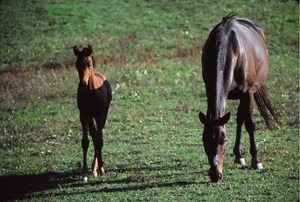The U.S. Food and Drug Administration (FDA) recently approved Quest Plus Gel for use in breeding, pregnant and lactating mares.

Quest Plus is a combination deworming product containing moxidectin and praziquantel. “Quest Plus Gel is simply our traditional Quest product with praziquantel added for control of tapeworms,” explains Kenton Morgan, DVM, an equine technical services veterinarian for Zoetis, manufacturer of the product. Moxidectin is effective against a variety of internal parasites including large and small strongyles, encysted cyathostomes, ascarids and pinworms.
“Several years ago when Fort Dodge brought Quest Plus to the market, they did not pursue the pregnant mare safety claim because both moxidectin and praziquantel had each individually demonstrated safety in previous pregnant mare studies,” explains Morgan. “Because of this, similar studies were not undertaken with moxidectin and praziquantel together in the same product formulation.”
Later, requests came from international markets to obtain the pregnant mare safety claim for Quest Plus, Morgan says, so Zoetis ran a safety trial on broodmares. A group of 10 healthy mares began receiving three times the label-recommended dosage shortly after a breeding soundness examination. Each of these mares received an additional five to seven doses at the elevated level at approximately two-week intervals until shortly after being confirmed pregnant. Each mare then received the elevated dosage every 30 days throughout the entire pregnancy until 30 days after foaling. An equal number of control mares received a placebo treatment (saline). In the trials, nine out of 10 mares receiving Quest Plus Gel at elevated dosages delivered live foals, while eight of 10 control mares receiving the placebo treatment produced live foals. The mares and foals were evaluated for any negative health effects; none were found.
“There was never really a question that this product would be safe for breeding mares,” says Morgan. “But it never hurts to have the testing done and be able to put that information on the label.”
This article first appeared in EQUUS issue #463, June 2016.








